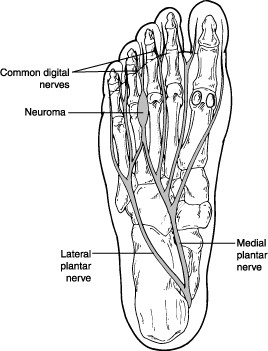Do you experience sensations of thickness, burning, numbness, electrical, ortingling in your toes or in the ball of your foot? Do these sensations occur in the area of your second, third or fourth toes? Is this pain present while walking or standing? Is the pain relieved by removing your shoesand/or massaging your feet?

Morton’s Neuroma
These are a few of the symptoms described by those suffering from a common foot condition known as a neuroma. It is also called a Morton’s neuroma. A neuroma is a thickening of nerve tissue that may develop in various parts of the body. Although almost always a benign (non-cancerous) condition, a neuroma can be quite annoying and cause extensive discomfort. A neuroma is caused by an irritation or compression of the nerve in the ball of the foot. It is usually described as a gradually increasing pain located between the base of the third and fourth toes. The involved nerve is sometimes squeezed and irritated by these adjacent metatarsal bones located in the ball of the foot, causing the painful neuroma to develop. This area is already subjected to considerable pressures from shoes and walking. Neuromas are more commonly a problem for women. High-heeled shoes with pointed tips cause additional pressure and irritation on the nerves in the ball of the foot. Individual complaints and symptoms for a neuroma can vary. Sometimes the symptoms go away from several months, then reappear.
A neuroma may be the result of an injury or from wearing the wrong shoes. Patients commonly have no recollection of any injury. A diagnosis of neuroma is based on the symptoms described by the patient. Sometimes an MRI can be used to assist in the diagnosis.
During the examination for a neuroma, squeezing the metatarsal heads together often causes pain (Mulder’s Sign) and a popping sensation is felt as the neuroma moves between the adjacent metatarsal heads.
Treatment with Orthotics
Conservative treatment can begin with padding the foot with a metatarsal pad.. Orthotic devices are very effective for treating this problem. Othertreatments include anti-inflammatory drugs, physical therapy, local steroid injections and changing of shoe type. Early diagnosis andtreatment of the problem will increase the success of conservative care.
Sclerosing Injections
A new treatment for a painful neuroma has demonstrated good results. A series of three to seven weekly injections of absolute dehydrated sterile alcohol and local anesthetic is injected into the area of the neuroma. When the solution is injected near the abnormal nerve tissue, the alcohol has a high affinity for nerve tissue, and a chemical degeneration occurs.
Some pain may accompany the first few injections, however this problem usually resolves quickly and is not necessarily associated with subsequent injections.
As with any conservative treatment, sclerosing injections may not be 100% effective. In the event that this treatment is not satisfactory, the injections do not have a negative impact on future surgical treatment options.
Surgical Treatment
Surgical removal of the involved nerve growth provides the best, long-lasting and often fastest relief from this painful condition. The surgery can be performed under local anesthesia (novocaine or Xylocaine) or using sedation anesthesia. The surgery involves the identification and removal of the abnormal nerve growth. Removal of a small portion of the nerve does not effect walking or standing. The procedure takes approximately twenty minutes. The patient can walk on the foot immediately after surgery, wearing a special surgical shoe and can return to work within a few days. A small dressing stays on the foot for two weeks.
